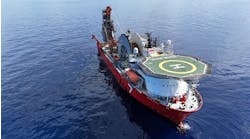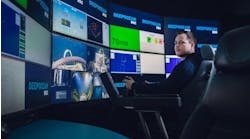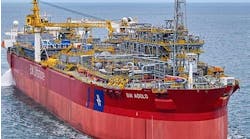Record-depth trees, Marimba manifold head deliveries
Nick TerdreKværner's expertise in subsea technology has in a short space of time enabled it to establish itself in Brazil where, among other assignments, it is engaged in developing subsea trees for state oil company Petrobras's deepwater requirements.
Contributing Editor
As the Brazilian upstream market opens up to foreign oil companies, the contractor is well placed to meet its upcoming development and production needs in ever deeper waters.
Kværner's presence in Brazil is headed by Kværner Oilfield Products (KOP), which uses the production facilities of the Kværner plant in Curitiba. The plant, which is certified to the ISO 9001 standard and is also used by the group's pulp and paper division, has been equipped to build subsea trees and will eventually expand the range of subsea products it is capable of manufacturing.
The move has benefited both divisions, according to Marco Fabbri, chief executive of the KOP group. It has enabled KOP Brazil to operate as a Brazilian company with its own manufacturing base. And, given that the pulping industry is prone to demand cycles, it has provided an alternative source of work which is welcome during the periods of low demand. Some 80% of the plant's capacity is currently taken up with work for KOP.
KOP Brazil has an engineering staff of some 50 persons. Apart from its president, Norwegian Kjell Pedersen, its employees have been recruited in Brazil.
Quick startup
Since starting up in 1996, it has already won some $100 million worth of orders. One of its first contracts for Petrobras was to develop and built a subsea control system rated for up to 1,000 meters, which is now installed in waters of 600-700 meters on the Albacora Field in the Campos Basin.Following that, an order for 26 subsea trees has been received, together with handling and installation tools. Delivery began in mid-1997 and is continuing. The trees are designed for guidelineless installation in depths of up to 1,000 meters.
The firm also has developed an eight-slot subsea production manifold, together with control and connections systems, for the Marimba Field. When construction is completed at Curitiba, the manifold will be trucked to the coast and shipped to the field.
Another important reference is a contract from Petrobras to develop six guidelineless subsea trees for water depths down to 2,500 meters, the deepest trees yet ordered in the world. The specifications were drawn up by Cenpes, the Petrobras research center, under the Procap deepwater development program. This project is still in the engineering phase, and the first deliveries will be made next year, Fabbri says.
These are important formative projects for KOP Brazil, which calls on KOP centers elsewhere in the world for their particular forms of expertise: Houston for tree and wellhead technology; Aberdeen for control system know-how; and Oslo for manifold and connection systems expertise.
But with each new project, KOP Brazil enlarges its own capability - for example, the hydraulic couplings for the 26-tree order were developed in Brazil - and becomes better equipped to contribute to the cross-fertilization that Fabbri identifies as essential to the working of KOP worldwide.
"Our Brazilian staff will be able to support projects elsewhere, and play their part in developing new technology," he says. "Cross-fertilization helps us to avoid limitations on engineering resources, and provides economies by enabling us to use common designs adapted for local conditions," he says. By way of example, the connection and control systems design for the Marimba manifold draw on those developed by KOP for the Laminaria project in Australia.
Kværner's earlier development work on multiphase pumping has now paid off in the form of a coop eration agreement with Petrobras and Westinghouse to develop a subsea multiphase booster system known as SBMS 500. The motor-pump drive unit is to be delivered by Westinghouse, while Kværner is responsible for the data and retrieval systems and marinization, and is also the system integrator.
The prototype is designed for operation in 1,000 meters of water, and is due to be installed in the second quarter of 1999 on a Campos Basin well. It will make it possible to tie back wells which would be too distant to tie back using natural pressure.
Kværner is also the contractor for a demonstration project of the Vertical Annular Separation and Pumping System (VASPS) which is being developed by Agip, Mobil and Petrobras. This is a system for separating liquids and gas on the seabed, to enable them to be transported separately back to a host platform for further processing.
Technology development
"We see Brazil as an important market in itself, but also as a developing ground for new technology," says Fabbri. The name of the game in Brazil is almost all deepwater, and interesting projects now looming on the horizon are Bijupira Salema, Roncador, and Barracuda/Caratinga, in water depths ranging from 650 meters to 1,700 meters.Petrobras, which has been pursuing the elusive goal of self-sufficiency for more than 20 years, is now looking to the use of turnkey contracts to get some of its many undeveloped finds swiftly on stream. This is a trend which Fabbri welcomes, in view of the wide range of technology available within the group and its project management skills.
"Together with Kværner Oil & Gas we can put together an overall offer which draws on the group's all-round strengths, with KOP taking responsibility for the whole of the subsea part," he says.
Among Kværner's subsea technologies which Fabbri sees as interesting for the Brazilian sector are the high integrity pipeline protection system (HIPPS) for high-pressure reservoirs, as installed on Shell's Kingfisher Field in the UK, the steel-tube umbilical which has been sold to projects in the Gulf of Mexico as well as the North Sea, and a subsea distribution system for chemicals which is currently under development.
KOP Brazil's close relationship with Petrobras should stand it in good stead as other players enter the market. Most of the oil companies interested in entering Brazil are looking for some form of cooperation with Petrobras in view of its intimate knowledge of its own offshore sector.
KOP Brazil is also the point from which the KOP group intends to serve other offshore markets in South America, of which the most important currently is Argentina.
Copyright 1998 Oil & Gas Journal. All Rights Reserved.


